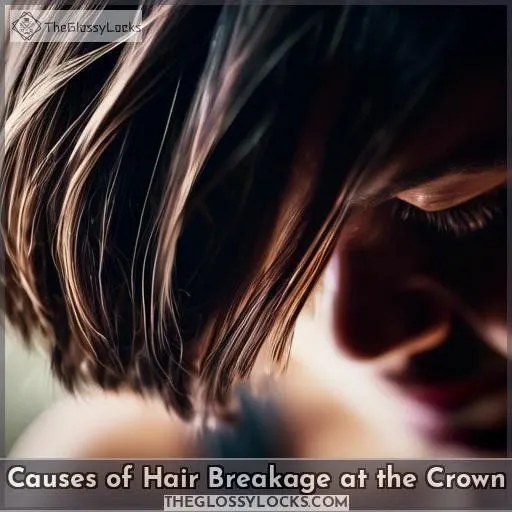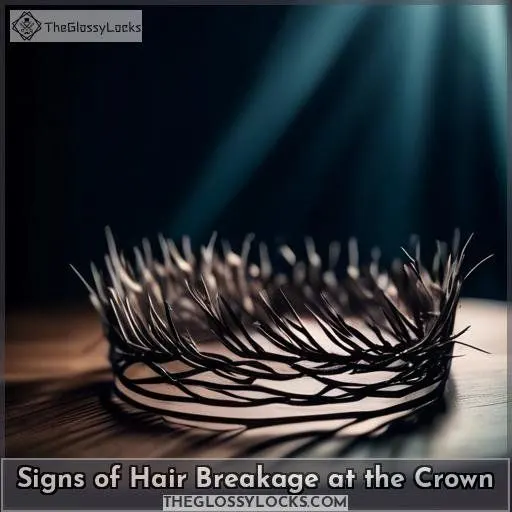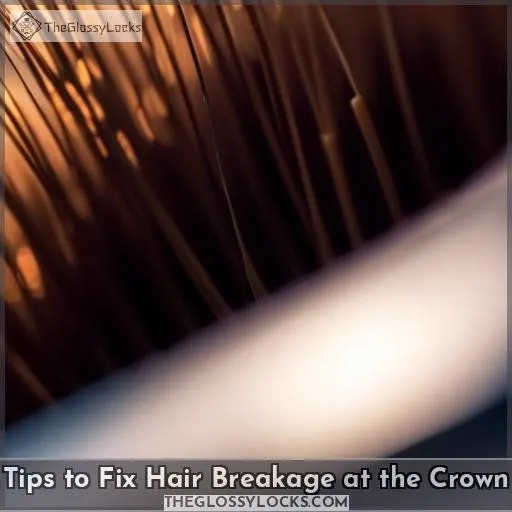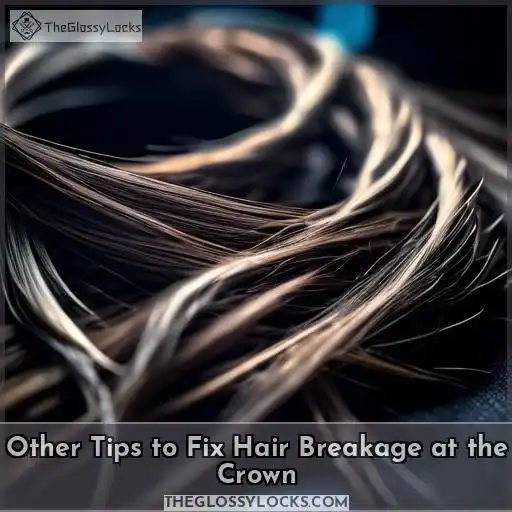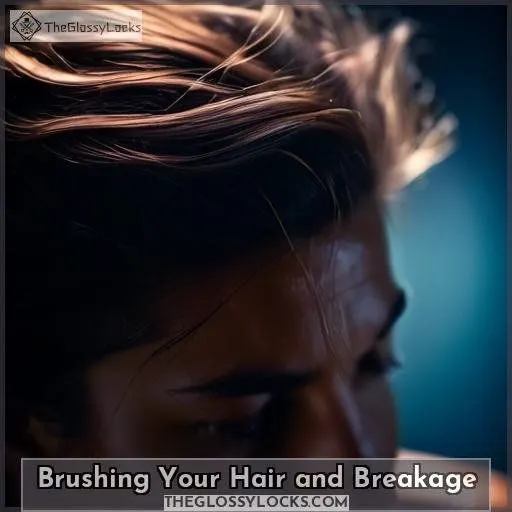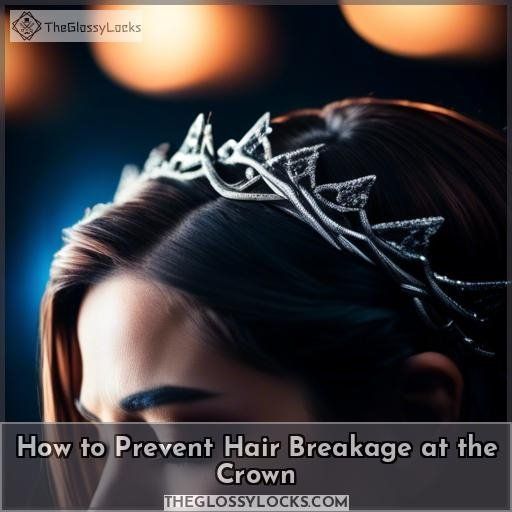This site is supported by our readers. We may earn a commission, at no cost to you, if you purchase through links.
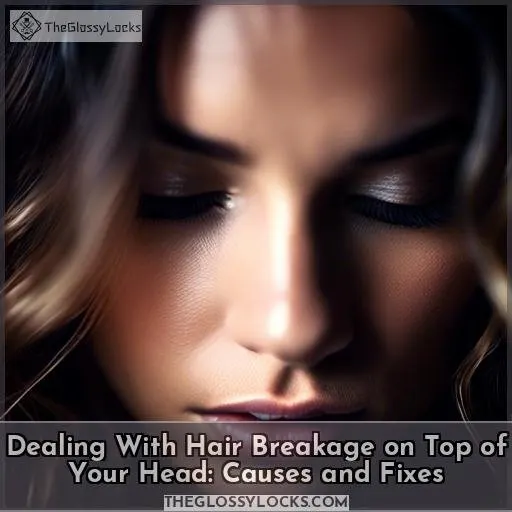
Hair breakage on top of your head often stems from excessive heat styling, tight hairstyles, and nutritional deficiencies.
You’ll notice dry scalp, hair loss, split ends, and brittle locks.
Embrace a hair growth routine.
Trim ends regularly, and limit heat styling to minimize damage.
Incorporate moisturizing treatments, oils, and detangling sprays to nourish strands.
Be gentle when combing, and consider growing out your natural color.
Utilizing protective products, scalp massages, hair masks, and stress reduction techniques can also prevent further breakage on the crown.
Implementing these tips holistically will restore your hair’s health and beauty.
Table Of Contents
- Key Takeaways
- Causes of Hair Breakage at the Crown
- Signs of Hair Breakage at the Crown
- Tips to Fix Hair Breakage at the Crown
- Other Tips to Fix Hair Breakage at the Crown
- Brushing Your Hair and Breakage
- How to Prevent Hair Breakage at the Crown
- Frequently Asked Questions (FAQs)
- What is the best way to brush your hair to prevent breakage at the crown?
- How often should you get your hair trimmed to prevent breakage at the crown?
- What are the best hair care products to use for hair breakage at the crown?
- How can you protect your hair from environmental factors that contribute to breakage at the crown?
- Can wearing tight hairstyles cause hair breakage at the crown?
- Conclusion
Key Takeaways
- Hair breakage at the crown can be caused by excessive heat styling, tight hairstyles, and nutritional deficiencies, leading to symptoms like dry scalp, hair loss, split ends, and brittle hair.
- To prevent heat styling damage, it’s crucial to use appropriate temperature settings for your hair type and always apply a heat protectant spray or cream.
- Tight hairstyles can lead to traction alopecia and restrict blood flow to the scalp, so opting for looser hairstyles and using hair-friendly accessories can help alleviate stress on the hair follicles.
- Incorporating a comprehensive hair care routine that includes regular trims, moisturizing treatments, gentle detangling, and stress reduction techniques can help restore and maintain the health of your hair.
Causes of Hair Breakage at the Crown
Are you struggling with hair breakage at the crown of your head? The culprits may be your daily heat styling routine, tight hairstyles that put stress on your strands, or nutritional deficiencies that impact hair health. Understanding the underlying causes is the first step in addressing this common hair woe.
Heat Styling Damage
To prevent heat styling damage and hair breakage, it’s essential to use the appropriate temperature settings on your flat iron or curling iron. Different hair types need different temperatures to safeguard your hair from unnecessary damage.
For fine hair, the optimal temperature range is 350°F – 375°F.
For coarse or thick hair, a higher temperature of 400°F – 450°F is suggested.
Always remember to use a heat protectant spray or cream to shield your hair from heat damage.
Tight Hairstyles Stress
Tight hairstyles can be a major cause of hair breakage, particularly at the crown of your head. These styles can create tension on the hair follicles and scalp, leading to a condition called traction alopecia, which is characterized by gradual hair loss due to repeated pulling or tension on the hair roots. Additionally, tight hairstyles can restrict blood flow to the scalp, depriving hair follicles of essential nutrients and oxygen, further contributing to hair thinning and loss.
To avoid hair breakage caused by tight hairstyles, consider the following tips:
- Opt for looser hairstyles: Instead of tightly pulled styles, choose looser alternatives that exert less tension on the hair follicles and scalp. Loose braids, gentle ponytails, or simply letting your hair down can help alleviate the strain on your hair.
- Choose hair-friendly accessories: Be mindful of the accessories you use in your hairstyles. Opt for hair-friendly alternatives such as fabric-covered hair ties or scrunchies, which are gentler on the hair and less likely to cause breakage.
- Give your hair a break: Regularly give your hair a break from tight hairstyles to allow it to rest and recover. Embrace natural hairstyles or loose styles whenever possible to reduce stress on your hair follicles.
- Maintain a healthy hair care routine: Invest in nourishing shampoos and conditioners to keep your hair and scalp healthy. Regular scalp massages can also help improve blood circulation and stimulate hair growth.
- Avoid over-styling: Limit the use of heat styling tools and harsh chemicals on your hair, as they can weaken the hair shaft and contribute to hair breakage and fall.
Nutritional Deficiencies Impact
Nutritional deficiencies can also contribute to hair breakage at the crown. A diet lacking in protein, vitamins, and minerals can weaken hair strands, making them more prone to damage. Iron deficiency, for example, can lead to hair loss. To address this, consider adding supplements or dietary changes to support hair growth and health.
Signs of Hair Breakage at the Crown
Hair breakage at the crown can manifest in several ways, and it’s crucial to recognize these signs to address the issue effectively. Here are some indicators of hair breakage at the crown:
- Dry scalp: A dry scalp can be a sign of hair breakage, as it may indicate that the hair follicles are weakened and prone to breakage.
- Hair loss: Hair loss at the crown can be a sign of hair breakage, as the hair may be falling out from the follicle due to damage.
- Split ends: Split ends can be a sign of hair breakage, especially if they’re more prevalent at the crown of your head.
- Brittle hair: Brittle hair can be a sign of hair breakage, as it may be more prone to snapping or breaking.
- Scalp pain: Pain in the scalp can be a sign of hair breakage, as the tension on the follicles can cause discomfort.
These signs can help you identify hair breakage at the crown and take steps to address the issue.
Tips to Fix Hair Breakage at the Crown
After uncovering the telltale signs of hair breakage at the crown, it’s time to arm yourself with strategies to combat this unruly foe. Imagine your hair as a garden that thrives on tender love and care. Here’s how to nurture it back to health:
- Embrace a hair growth routine that includes stimulating scalp massages to enhance circulation.
- Trim those split ends regularly to prevent further damage.
- Swap harsh brushes for gentle detangling tools.
- Limit heat styling to a minimum, letting your hair’s natural beauty shine.
- Shield your locks from the elements with protective styles and products.
Other Tips to Fix Hair Breakage at the Crown
Other tips to fix hair breakage at the crown include:
Incorporating moisturizing treatments into your hair care routine, such as hair masks and scalp massages.
Using hair oils to nourish your hair and protect it from damage.
Opting for a detangling spray instead of brushing your hair when it’s wet.
Being gentle when combing to avoid breakage.
Considering growing out your natural hair color instead of using harsh chemical treatments.
By implementing these tips, you can help prevent and repair hair breakage on top of your head.
Brushing Your Hair and Breakage
Grooming your hair is an essential part of maintaining its well-being, but it can also contribute to breakage if done incorrectly.
Begin by using a detangling spray to smooth out knots before brushing.
If you’re using a blow dryer, opt for a wide-toothed comb to minimize breakage.
Don’t brush too hard or too often, and avoid excessive brushing.
Embrace the power of a good brush, but don’t let it dictate your routine.
With these tips, you’ll be able to keep your hair breakage-free and tangle-free.
How to Prevent Hair Breakage at the Crown
To prevent hair breakage at the crown, it’s essential to establish a few simple routines.
Firstly, utilize hair products that shield your hair from damage. Choose hair growth conditioners, shampoos, and serums that nourish your scalp and promote healthy hair growth.
Secondly, incorporate scalp massages into your routine. These massages foster blood flow and promote hair growth.
Thirdly, experiment with hair oils and masks to hydrate your hair and prevent breakage.
Finally, mitigate stress, which can contribute to hair loss and breakage. Engage in stress reduction techniques such as meditation or yoga to maintain the health and strength of your hair.
Frequently Asked Questions (FAQs)
What is the best way to brush your hair to prevent breakage at the crown?
You’ll want to use a wide-tooth comb or detangling brush, starting from the ends and gently working up. Be gentle, take your time, and don’t over-brush – that can cause snapping and breakage at the delicate crown area.
How often should you get your hair trimmed to prevent breakage at the crown?
Aye, mateys! To keep yer crown lookin’ shipshape, ye should be gettin’ regular trims every 6-8 weeks. This’ll help snip off those pesky split ends preventin’ further breakage an’ keepin’ yer locks sturdy as oak.
What are the best hair care products to use for hair breakage at the crown?
You’ll want to use hydrating, protein-rich products like coconut oil, aloe vera gel, and keratin serums/masks. Avoid sulfates and give deep conditioning treatments weekly for intense nourishment. A silk pillowcase can also minimize breakage while you sleep.
How can you protect your hair from environmental factors that contribute to breakage at the crown?
You can protect your crown’s delicate strands by wearing a wide-brimmed hat to shield it from harsh sunrays and using a lightweight heat protectant spray before any heat styling. This double defense will keep your tresses shielded and strong.
Can wearing tight hairstyles cause hair breakage at the crown?
Picture hair strands as delicate threads – tightly pulling can snap them. Yes, wearing tight hairstyles like ponytails or braids repeatedly stresses and breaks off hair at the crown. Loosen up for healthier tresses.
Conclusion
Hair breakage on top of your head should not dishearten you, though frustrating. By pinpointing and addressing the underlying causes—whether it’s heat styling, tight hairstyles, or nutritional imbalances—and adopting a thorough hair care routine designed specifically for your needs, you can effectively combat this issue.
Consistently caring for your strands with gentle handling, protective products, and scalp stimulation will foster a healthy, resilient crown over time.
Persevere, and you’ll witness a remarkable transformation in your hair’s strength and vitality.

